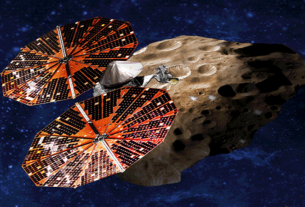The NASA space agency announced today, Thursday, that it will send a space robot to Saturn’s largest moon, Titan, which shares many characteristics with Earth and could hide the secrets of the origin of life on our planet.
“This mission would have been unimaginable just a few years ago (…) NASA once again does what no one else can,” said special agency administrator Jim Bridenstine, in a statement.
NASA will send its space robot, baptized “Dragonfly” (Dragonfly), in 2026, and several years later, in 2034, the ship will land on the icy surface of Titan.
It is the first time that NASA sends a multi-rotor vehicle (with several propellers) to another planet on a scientific mission, the space agency said in its statement.
“Dragonfly,” which has eight propellers and resembles a large drone, will examine Titan’s surface for almost three years in search of chemical processes similar to those on Earth.
The robot will explore different corners of Titan: from sand dunes to the floor of a crater where scientists hope to find liquid water and other organic materials, materials that could offer clues to the origin of life that may have existed in that celestial body. Tens of thousands of years.
Also, according to NASA, “Dragonfly” will investigate the atmospheric properties of Titan and will try to find any chemical evidence about the existence of living organisms.
The Titan satellite, which is as big as Mercury, gathers a series of compounds that make it similar to the planet Earth in its “primitive” phase, that is, in its first phases of existence.
Therefore, NASA hopes to find among its dunes and lakes the secrets about the origin of terrestrial life.
In this regard, the associate administrator of the direction of scientific missions of NASA, Thomas Zurbuchen, explained that “Dragonfly” will examine a “variety of organic compounds, which are the building blocks of life and could offer lessons on the origin of life itself.”
Like Earth, Titan has a dense atmosphere of nitrogen, but, unlike our planet, the satellite is surrounded by clouds and methane rain, detailed NASA.
The mission to Saturn’s satellite is part of NASA’s “New Frontiers” program, which supports scientific missions that have been identified as priorities within the solar system.




